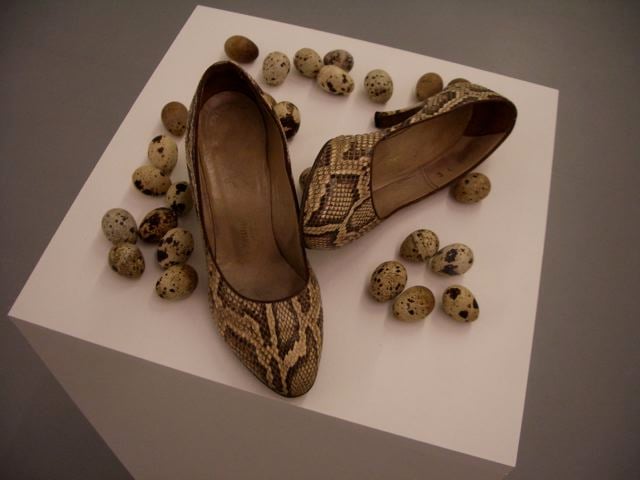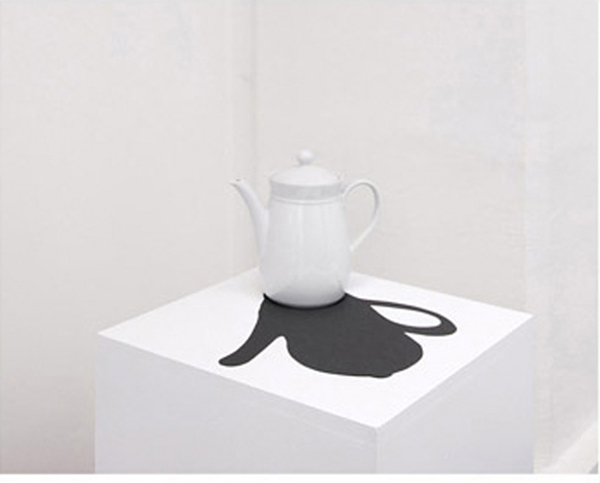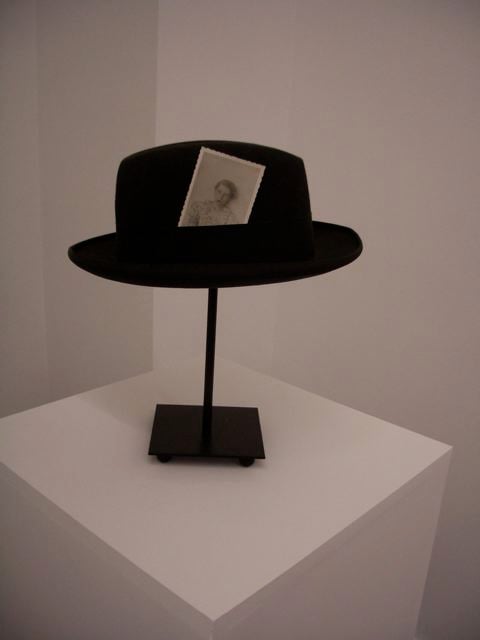
© » KADIST
Mariana Castillo Deball
Do ut des (2009) is part of an ongoing series of books that Castillo Deball has altered with perforations, starting from the front page and working inward, forming symmetrical patterns when each spread is opened. The books belong to O Mundo dos Museus (The World of Museums), a collection conceived by the Brazilian designer Eugênio Hirsch in the 1970s. More than simply a catalogue of artworks, each offers the reader a promenade through a different world museum and its functioning, starting with photo reportage of the building, its urban landscape and architecture, the management and restoration of works, and visitors walking though the galleries.

© » KADIST
Agnieszka Kurant
For Sentimentite Agnieszka Kurant collaborated with Justin Lane, CEO and Co-Founder of CulturePulse, to gather global sentiment data that has been harvested from millions of Twitter and Reddit posts related to 100 seismic events in recent history. Kurant’s fictional mineral-currency is at once data visualization, a sly commentary on global markets, and a speculative narrative about the connection between technology and geology (for example ‘conflict minerals’ used in smartphones). Inspired by the way natural forces shape rocks, landscape, and planets over time, Sentimentite ’s evolving forms are shaped by dynamic social and political ruptures in the 21st century.

© » KADIST
Agnieszka Kurant
For Sentimentite Agnieszka Kurant collaborated with Justin Lane, CEO and Co-Founder of CulturePulse, to gather global sentiment data that has been harvested from millions of Twitter and Reddit posts related to 100 seismic events in recent history. Kurant’s fictional mineral-currency is at once data visualization, a sly commentary on global markets, and a speculative narrative about the connection between technology and geology (for example ‘conflict minerals’ used in smartphones). Inspired by the way natural forces shape rocks, landscape, and planets over time, Sentimentite ’s evolving forms are shaped by dynamic social and political ruptures in the 21st century.

© » KADIST
Agnieszka Kurant
For Sentimentite Agnieszka Kurant collaborated with Justin Lane, CEO and Co-Founder of CulturePulse, to gather global sentiment data that has been harvested from millions of Twitter and Reddit posts related to 100 seismic events in recent history. Kurant’s fictional mineral-currency is at once data visualization, a sly commentary on global markets, and a speculative narrative about the connection between technology and geology (for example ‘conflict minerals’ used in smartphones). Inspired by the way natural forces shape rocks, landscape, and planets over time, Sentimentite ’s evolving forms are shaped by dynamic social and political ruptures in the 21st century.

© » KADIST
Jeffrey Vallance
Vallance’s Rocket is a vibrant picture in which masses of color and collage coalesce into a central vehicle, yet the whole surface seems lit with the roar of space travel. This varied use of media has enabled the artist to bring all of the life, energy, and objects he works with into a single image.

© » KADIST
Oliver Laric
Oliver Laric’s video Versions is part of an ongoing body of work that has continued to evolve and mutate over time. Comprised of several video and sculptural works that share the same title, the Versions series reflects Laric’s key concerns: the mutability of images and objects and the negotiation between original and copy. In this video, we see several 3D renders of recognizable objects and places, while an ubiquitous feminized robotic voice that evokes the domestic familiarity of voice recognition tools such as Siri and Alexa, speaks of issues relating to identity, language, and translation.

© » KADIST
Mariana Castillo Deball
Taking archaeology as her departure point to examine the trajectories of replicated and displaced objects, “Who will measure the space, who will tell me the time?” was produced in Oaxaca for her exhibition of the same title at the Contemporary Museum of Oaxaca (MACO) in 2015. The sculpture, employing the technique of traditional Atzompa pottery originating from Oaxaca, Mexico, is an examination of the way in which archaeological heritage is remembered in the earthenware made by Atzompa potters today. Accompanied by the publication ‘Ixiptla Vol.

© » KADIST
Mariana Castillo Deball
Mariana Castillo Deball’s set of kill hole plates are part of a larger body of work problematizing archeological narratives, and drawing attention to the conservation process and its role in recreating an imagined object. They are playful and exaggerated representations of “kill hole pottery” — ceramic dishes in the Mimbres tradition with distinct circular holes located in the center of the pots. Although very little is known about the Mimbres culture’s specific beliefs, they are loosely understood to have terminated the object symbolically in preparation for funerary use.

© » KADIST
Hans-Peter Feldmann
The types of objects Feldmann is interested in collecting into serial photographic grids or artist’s books are often also found in three dimensional installations. Verging on a form of fetichism, his shoe collections are a case in point and indeed, for some exhibitions, he even asked gallery employees for their shoes. Against authorship and the commodification of art, he never gives titles or dates to his works which have infinite edition possibilities.

© » KADIST
Hans-Peter Feldmann
The types of objects Feldmann is interested in collecting into serial photographic grids or artist’s books are often also found in three dimensional installations. Against authorship and the commodification of art, he never gives titles or dates to his works which have infinite edition possibilities. This mise en scène of found kitchenware also exists with a rounder and flatter plain modern white porcelain teapot.

© » KADIST
Hans-Peter Feldmann
The types of objects Feldmann is interested in collecting into serial photographic grids or artist’s books are often also found in three dimensional installations. Hats and photographs are regularly part of his appropriations and arrangements. He famously made numerous trips to England in search of old photographs when he was an antique dealer, and then worked in a gift store with his wife when he left the art world in the 1980s.

© » KADIST
Agnieszka Kurant
Drawing & Print (Drawing & Print)
Agnieszka Kurant’s Placebo VIII brings together a series of imaginary pharmaceuticals invented within the fictional narratives of literature and film. Displayed in a custom cabinet, these imaginary drugs are materialized as physical objects, packaged in meticulously designed boxes, listing dosage and description information along with references to the fictional source. Each box is filled with placebo tablets.

© » KADIST
Allen Ruppersberg
Untitled (City Limits) is a series of five black-and-white photographs of road signs, specifically the signs demarcating city limits of several small towns in California. Taken outside Palmdale, Littlerock, Pearlblossom, Victorville, and Barstow, towns where the population does not exceed 20,000, Ruppersberg’s trip follows the outskirts of Los Angeles. As with many of his other photographic series, the artist here inserted into each view a constant element that disturbs the otherwise quiet scenes: a hand holding an open magazine.
Mariana Castillo Deball
- location: Amsterdam & Berlin
- year born: 1975
- gender: female
- nationality: Mexican
- home town: Mexico City, Mexico
Hans-Peter Feldmann
- location: Düsseldorf, Germany
- year born: 1941
- gender: male
- nationality: German
- home town: Dusseldorf, Germany
Oliver Laric
- location: Berlin, Germany
- year born: 1981
- gender: male
- nationality: Austrian
- home town: Innsbruck, Austria
Allen Ruppersberg
- year born: 1944
- gender: male
- nationality: American
- home town: Cleveland, Ohio
-
1970-1979
Allen Ruppersberg
1970Untitled (City Limits) is a series of five black-and-white photographs of road signs, specifically the signs demarcating city limits of several small towns in California...
Jeffrey Vallance
1978Vallance’s Rocket is a vibrant picture in which masses of color and collage coalesce into a central vehicle, yet the whole surface seems lit with the roar of space travel...
-
2000-2009
Mariana Castillo Deball
2009Do ut des (2009) is part of an ongoing series of books that Castillo Deball has altered with perforations, starting from the front page and working inward, forming symmetrical patterns when each spread is opened...
-
2010-2019
Oliver Laric
2012Oliver Laric’s video Versions is part of an ongoing body of work that has continued to evolve and mutate over time...
Mariana Castillo Deball
2015Taking archaeology as her departure point to examine the trajectories of replicated and displaced objects, “Who will measure the space, who will tell me the time?” was produced in Oaxaca for her exhibition of the same title at the Contemporary Museum of Oaxaca (MACO) in 2015...
Agnieszka Kurant
Drawing & Print
2018(Drawing & Print) Agnieszka Kurant’s Placebo VIII brings together a series of imaginary pharmaceuticals invented within the fictional narratives of literature and film...
-
2020-2029
Agnieszka Kurant
2022For Sentimentite Agnieszka Kurant collaborated with Justin Lane, CEO and Co-Founder of CulturePulse, to gather global sentiment data that has been harvested from millions of Twitter and Reddit posts related to 100 seismic events in recent history...
Agnieszka Kurant
2022For Sentimentite Agnieszka Kurant collaborated with Justin Lane, CEO and Co-Founder of CulturePulse, to gather global sentiment data that has been harvested from millions of Twitter and Reddit posts related to 100 seismic events in recent history...
Agnieszka Kurant
2022For Sentimentite Agnieszka Kurant collaborated with Justin Lane, CEO and Co-Founder of CulturePulse, to gather global sentiment data that has been harvested from millions of Twitter and Reddit posts related to 100 seismic events in recent history...